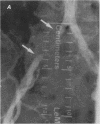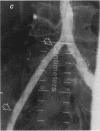Abstract
We performed a prospective randomized study to compare the use of a bare metal stent (WALLSTENT Endoprosthesis) with use of a covered stent (WALLGRAFT Endoprosthesis)-both made by Schneider, Inc.; Minneapolis, Minn-for the treatment of complex iliac artery stenosis and occlusion. We report the preliminary results of a study performed at our institution from 1 February 1997 through 31 April 1997. The patient group was composed of 6 women and 4 men, with a mean age of 61.8 years (range, 47 to 73 years). Six WALLGRAFT endoprostheses (4 in the left iliac artery and 2 in the right) and 9 WALLSTENT endoprostheses (5 in the left iliac artery and 4 in the right) were implanted. The mean percent stenosis before treatment was similar in both groups (84.17% in the WALLGRAFT group and 82.14% in the WALLSTENT group). The post-treatment stenosis and peak systolic gradients were negligible or zero in both groups. The devices were safely deployed and technical success (< 30% residual stenosis) was achieved in both groups. The mean thigh-brachial index was similar in the 2 groups, both before treatment (0.65 in the WALLGRAFT group and 0.64 in the WALLSTENT group) and after treatment (1.12 in the WALLGRAFT group and 1.12 in the WALLSTENT group). Evaluation of clinical success revealed that symptoms of intermittent claudication improved markedly in 4 of 5 patients who received the WALLGRAFT Endoprosthesis. In the WALLSTENT group, 1 patient had symptomatic improvement, another had 1 limb improve and the other worsen, and the rest had no improvement. Clinical complications were observed in only 1 patient in the WALLGRAFT group and in 2 patients in the WALLSTENT group. These preliminary results indicate very good technical and early success at the 1-month follow-up with the use of the WALLGRAFT Endoprosthesis in complex iliac artery stenosis and occlusion. Despite these promising preliminary results, a longer follow-up study with a larger number of patients is needed to determine the benefits of the WALLGRAFT Endoprosthesis in patients with complex iliac artery stenosis or occlusion.
Full text
PDF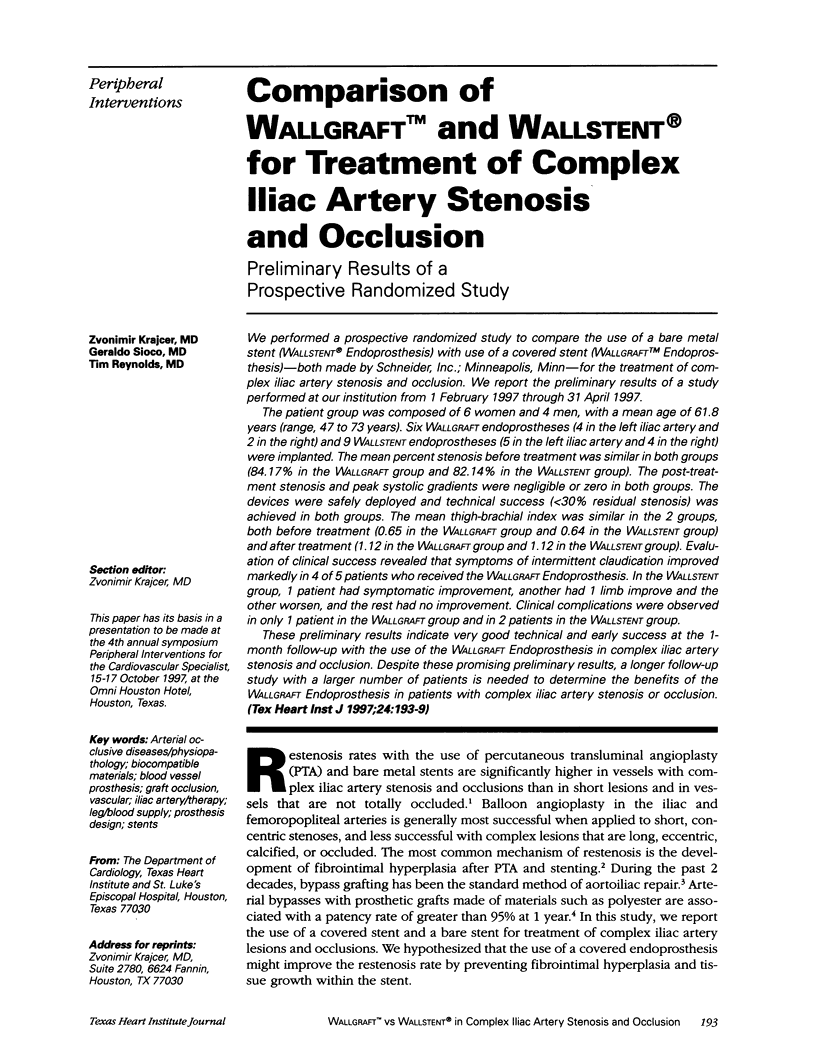
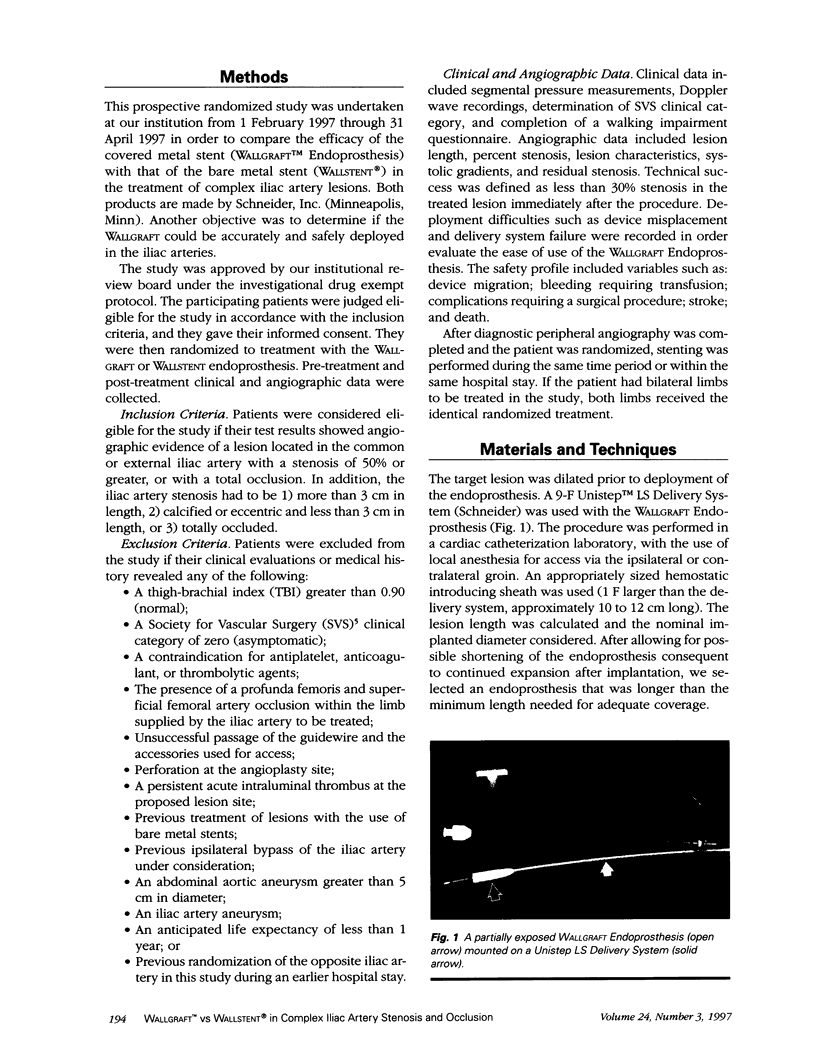
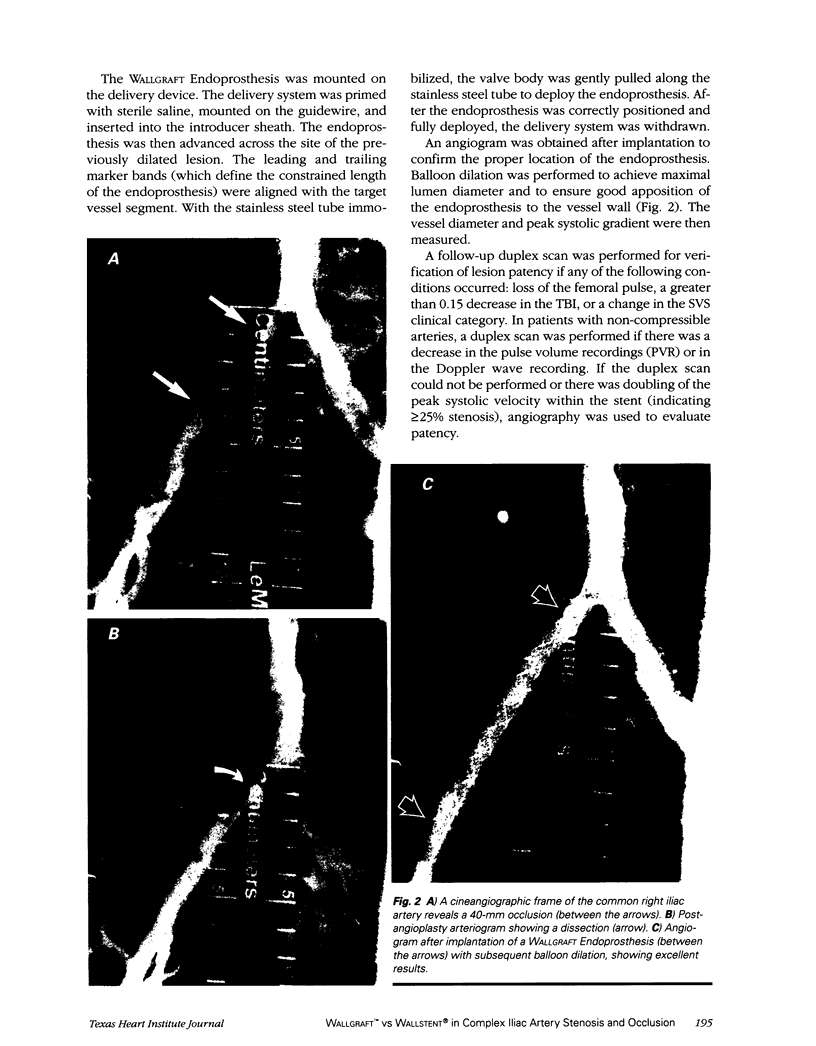
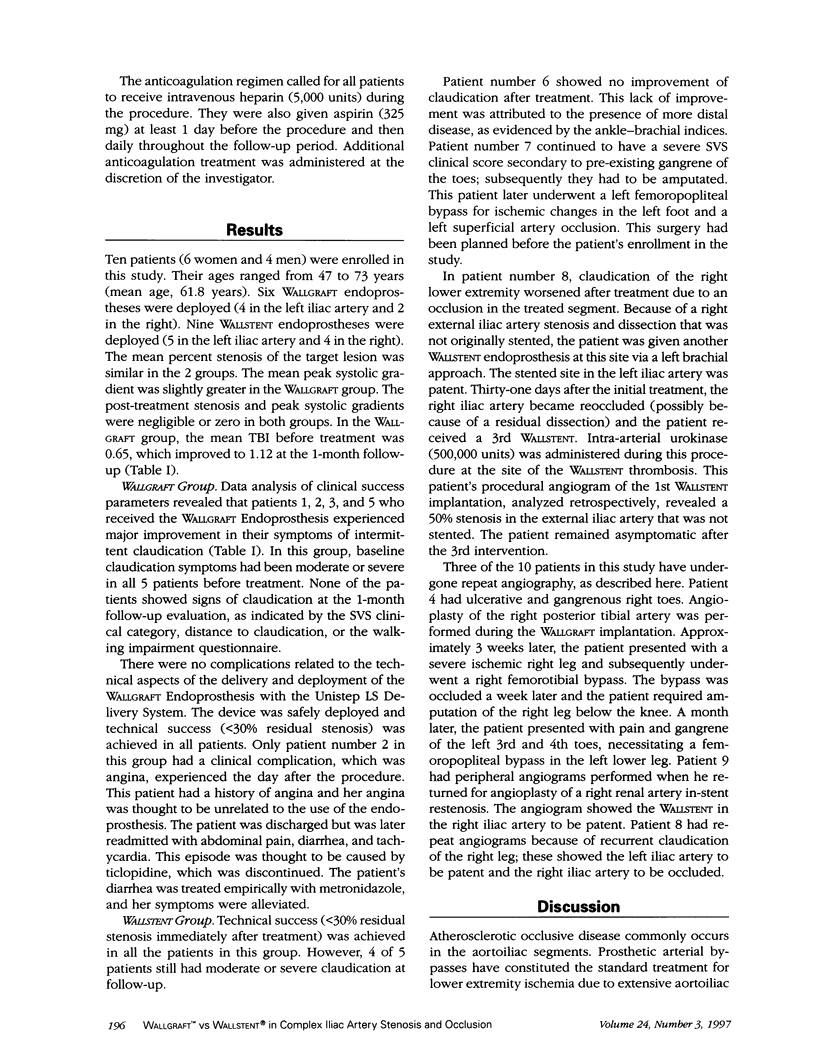
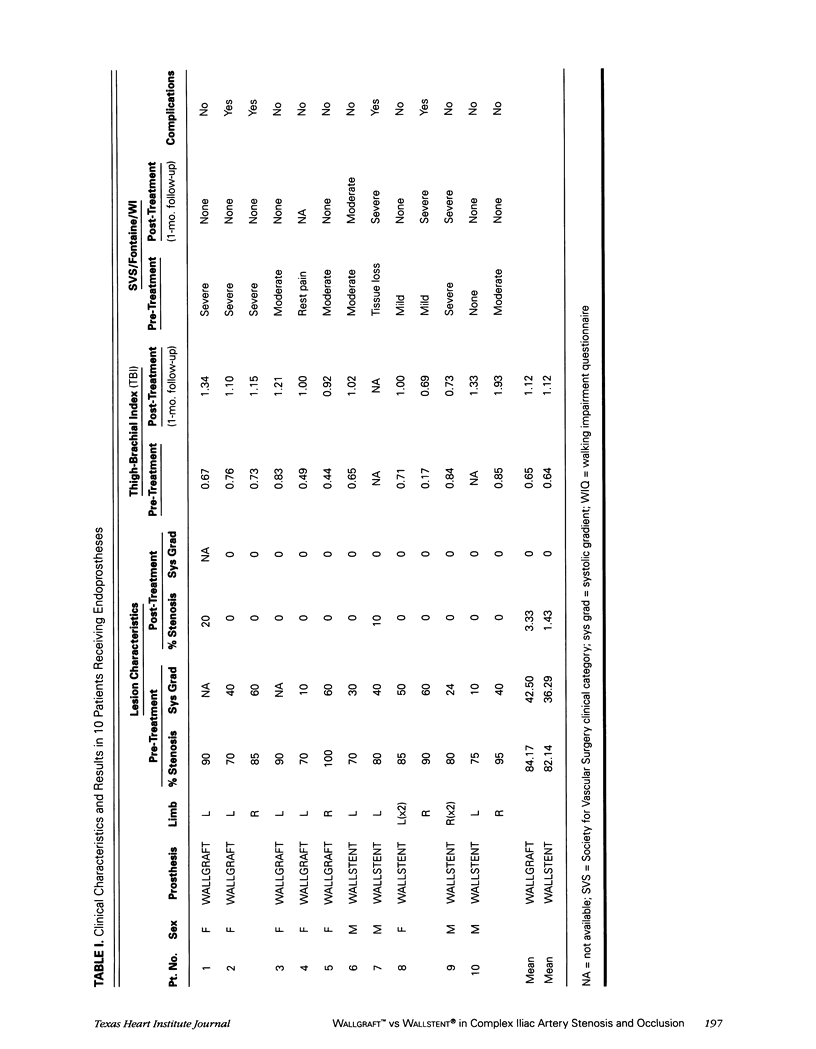
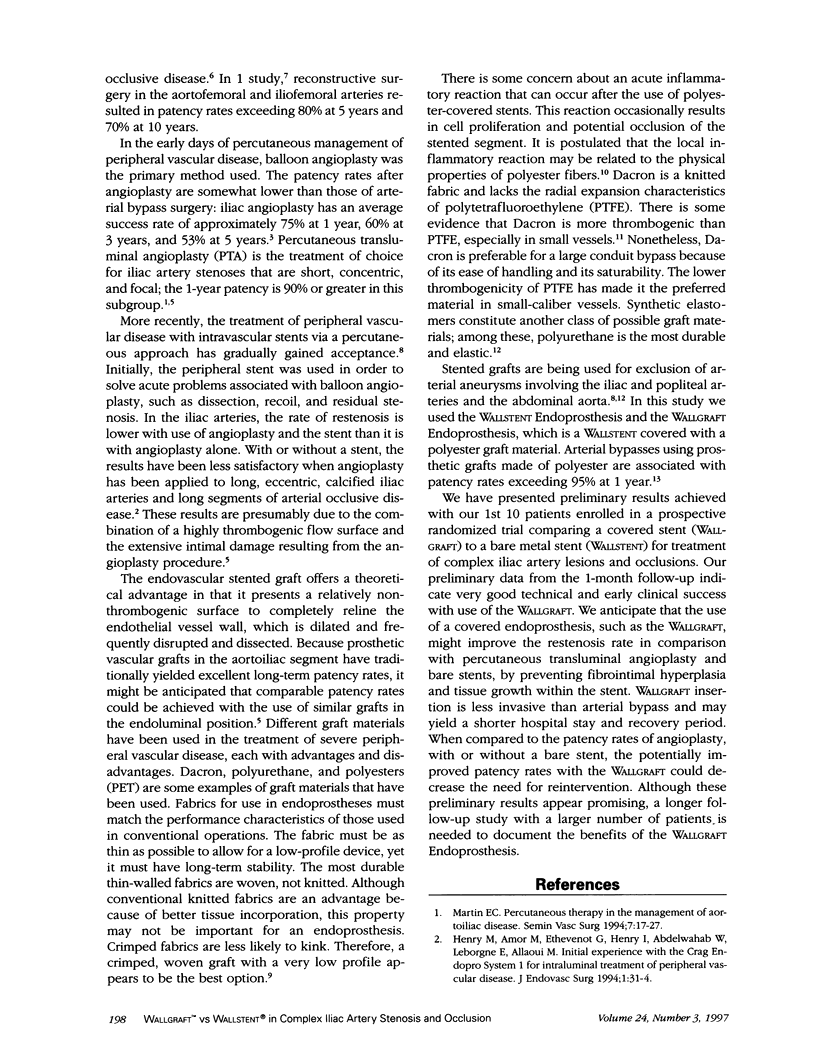
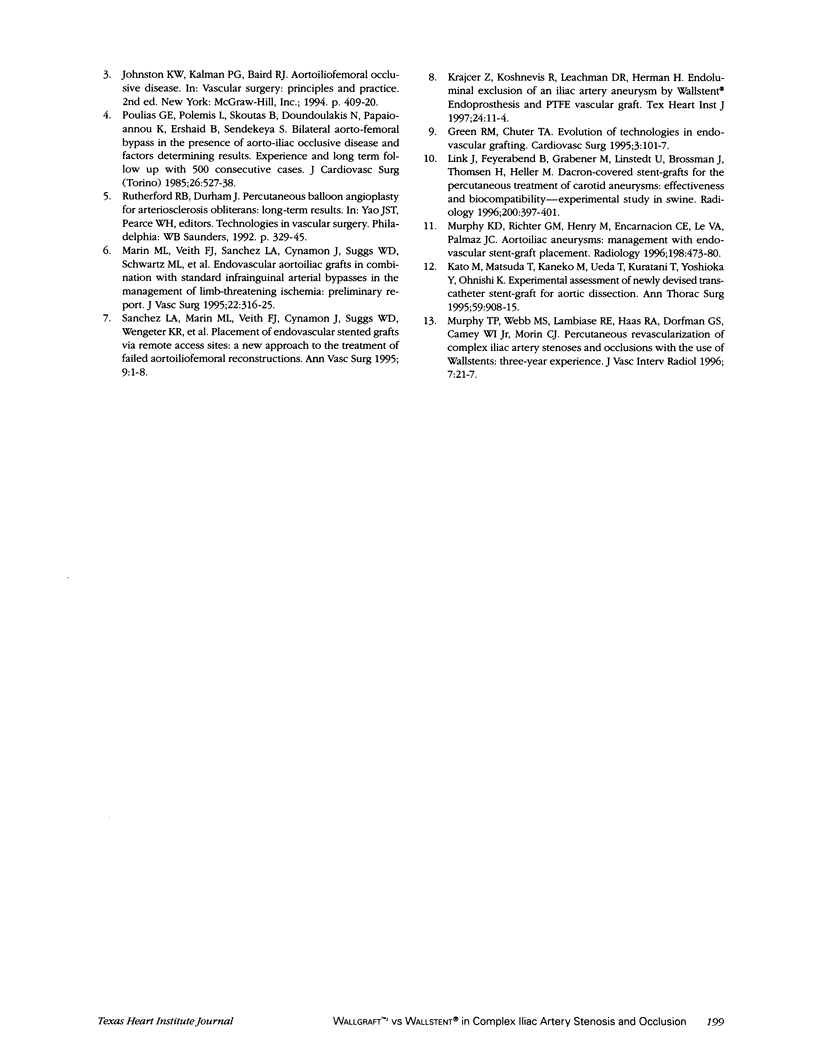
Images in this article
Selected References
These references are in PubMed. This may not be the complete list of references from this article.
- Green R. M., Chuter T. A. Evolution of technologies in endovascular grafting. Cardiovasc Surg. 1995 Apr;3(2):101–107. doi: 10.1016/0967-2109(95)90881-5. [DOI] [PubMed] [Google Scholar]
- Henry M., Amor M., Ethevenot G., Henry I., Abdelwahab W., Leborgne E., Allaoui M. Initial experience with the Cragg Endopro System 1 for intraluminal treatment of peripheral vascular disease. J Endovasc Surg. 1994 Sep;1:31–43. doi: 10.1583/1074-6218(1994)001<0031:IEWTCE>2.0.CO;2. [DOI] [PubMed] [Google Scholar]
- Kato M., Matsuda T., Kaneko M., Ueda T., Kuratani T., Yoshioka Y., Ohnishi K. Experimental assessment of newly devised transcatheter stent-graft for aortic dissection. Ann Thorac Surg. 1995 Apr;59(4):908–915. doi: 10.1016/0003-4975(94)00958-a. [DOI] [PubMed] [Google Scholar]
- Krajcer Z., Khoshnevis R., Leachman D. R., Herman H. Endoluminal exclusion of an iliac artery aneurysm by Wallstent endoprosthesis and PTFE vascular graft. Tex Heart Inst J. 1997;24(1):11–14. [PMC free article] [PubMed] [Google Scholar]
- Link J., Feyerabend B., Grabener M., Linstedt U., Brossmann J., Thomsen H., Heller M. Dacron-covered stent-grafts for the percutaneous treatment of carotid aneurysms: effectiveness and biocompatibility--experimental study in swine. Radiology. 1996 Aug;200(2):397–401. doi: 10.1148/radiology.200.2.8685332. [DOI] [PubMed] [Google Scholar]
- Marin M. L., Veith F. J., Sanchez L. A., Cynamon J., Suggs W. D., Schwartz M. L., Parsons R. E., Bakal C. W., Lyon R. T. Endovascular aortoiliac grafts in combination with standard infrainguinal arterial bypasses in the management of limb-threatening ischemia: preliminary report. J Vasc Surg. 1995 Sep;22(3):316–325. doi: 10.1016/s0741-5214(95)70147-8. [DOI] [PubMed] [Google Scholar]
- Martin E. C. Percutaneous therapy in the management of aortoiliac disease. Semin Vasc Surg. 1994 Mar;7(1):17–27. [PubMed] [Google Scholar]
- Murphy K. D., Richter G. M., Henry M., Encarnacion C. E., Le V. A., Palmaz J. C. Aortoiliac aneurysms: management with endovascular stent-graft placement. Radiology. 1996 Feb;198(2):473–480. doi: 10.1148/radiology.198.2.8596852. [DOI] [PubMed] [Google Scholar]
- Murphy T. P., Webb M. S., Lambiase R. E., Haas R. A., Dorfman G. S., Carney W. I., Jr, Morin C. J. Percutaneous revascularization of complex iliac artery stenoses and occlusions with use of Wallstents: three-year experience. J Vasc Interv Radiol. 1996 Jan-Feb;7(1):21–27. doi: 10.1016/s1051-0443(96)70727-3. [DOI] [PubMed] [Google Scholar]
- Poulias G. E., Polemis L., Skoutas B., Doundoulakis N., Papaïoannou K., Ershaid B., Sendekeya S. Bilateral aorto-femoral bypass in the presence of aorto-iliac occlusive disease and factors determining results. Experience and long term follow up with 500 consecutive cases. J Cardiovasc Surg (Torino) 1985 Nov-Dec;26(6):527–538. [PubMed] [Google Scholar]
- Sanchez L. A., Marin M. L., Veith F. J., Cynamon J., Suggs W. D., Wengerter K. R., Schwartz M. L., Lyon R. T., Bakal C. W., Parodi J. C. Placement of endovascular stented grafts via remote access sites: a new approach to the treatment of failed aortoiliofemoral reconstructions. Ann Vasc Surg. 1995 Jan;9(1):1–8. doi: 10.1007/BF02015310. [DOI] [PubMed] [Google Scholar]




